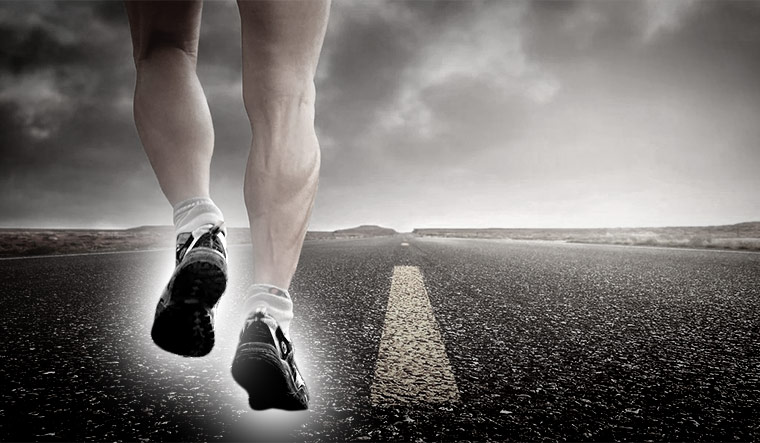In 2016, a parliamentary standing committee noted that India spent just three paisa per capita per day on sports—the US, by contrast, spent Rs 22.
It is no secret that countries with more money to spend on sports can outperform those that don’t. As a 2017 paper on the effect of public expenditure on sports on medal share noted, “Olympic success is a zero sum game. If increasing public sporting expenditures increases a country’s medal share, the medal shares of all other participating countries naturally decreases.”
While Olympic sports like the 200m and 400m races have been around for thousands of years, modern athletes would give their ancient peers a run for their money, and not just on account of their fitness. Modern running shoes, tracks, and training methods make contemporary athletes capable of breaking records by larger and larger intervals.
While Tokyo 2020 saw possibly the most stringent efforts yet to tackle the problem of doping, it also saw technology come to the forefront of an athlete’s performance. When world records in both the men’s and women’s 400-metre hurdles were broken during both the June Olympic trials and the Olympics themselves, all four athletes were using a shoe technology called “super spikes”.
This technology makes use of ultra-light foam energy-returning Pebax foam and curved carbon-fiber plates, that boost efficiency and reduce weight all at once. Scientific studies have confirmed its ability to reduce energy costs for the runner by up to 4 per cent.
By contrast, the winner of the men's 400 metres hurdles at Tokyo 2020 did so without the spikes. But despite his victory, Norwegian Karsten Warholm, criticised his American rival Rai Benhamin for wearing Nike’s Air Zoom Maxflysuper spikes. “He had those things in his shoes, which I hate. I don’t see why you should put anything beneath a sprinting shoe,” he said. “If you want cushioning, you can put a mattress there. But if you put a trampoline, I think it’s bull****, and I think it takes credibility away from our sport,” he said.
Of course, whether a shoe makes a race unfair or not depends on whether all the athletes are wearing it. The Nike ZoomX Vaporfly 4% retails at under Rs 19,695—an unaffordable price for many athletes at the starting stage. But the claimed 4 per cent improvement in performance could be the difference between a medal and nothing at all.
Concerns over the performance-boosting abilities of certain shoes have led the World Athletics to bar shoes that grant “unfair assistance or advantage”. Among shoemakers, Nike’s undisputed lead led to complaints, but also a surprising twist: Rival shoemakers allowed their sponsored athletes to wear Nikes.
Even the world’s fastest man has taken a stand against the shoes. Following criticisms of super spike technology and claims that they could allow ordinary athletes to beat Usain Bolt’s record, the Jamaican told Reuters, "When I was told about it I couldn’t believe that this is what we have gone to, you know what I mean, that we are really adjusting the spikes to a level where it’s now giving athletes an advantage to run even faster.”
"It's weird and unfair for a lot of athletes because I know that in the past they (shoe companies) actually tried and the governing body said 'No, you can't change the spikes', so to know that now they are actually doing it, it’s laughable,” the eight-time Olympic Champion added.
When Italian Lamont Marcell Jacobs took the 100m gold in what was largely seen as a surprise, he was wearing modified Nike spikes.
So what role does inequality play? Even among India’s most decorated athletes, Olympic-grade equipment isn’t an easy acquisition. National record-holder in 100m Dutee Chand had in 2016 requested the Odisha government to provide her with a new pair of spike shoes as hers had worn out. “The running shoes are quite expensive, and I request the state government to provide a set of tracksuit and a pair of running shoes so that I could give my best performance," Dutee was reported as saying.
If Chand could struggle to acquire these shoes, what of athletes who are not yet famous enough to write to their state’s chief ministers for aid?
An article on Inequality.org showed how gold medal tallies were dominated by richer countries, though smaller nations like Kenya and Jamaica could punch above their weight for other medals. A study by The Economist found that share of world GDP was the single biggest factor in determining success at the Olympics. “On average, holding other things constant, a two percentage-point share of global GDP (measured at purchasing-power parity) translates to a three percentage-point share of Olympics medals,” it noted.
This difference manifests in many more factors than just the equipment athletes use. Everything from the training facilities available to the athletes’ familiarity with participating in international events and under media glare to simply the ability of certain countries to dominate certain sports can determine Olympic success.
When technologies start adding undue advantage, governing agencies tend to ban them: Such was the fate of the LZR Racer swimsuit by Speedo (co-developed by NASA), which reduced friction in the water by a whopping 24 per cent. When 23 athletes at Beijing 2008 broke records after wearing it, it led to outcry that years later led the FINA international governing body of swimming to ban athletes from using the suit as it was deemed to have conferred an unfair advantage.
The debate over whether technology detracts from or adds to Olympic sports continues to rage. In an age where even the fabric on one’s body could be a performance-enhancer, what if you took out the technology entirely then?
A BBC article titled “What if Olympic athletes went back to competing naked?” examined the history of naked athletes at the Olympics, a feat that was seen in ancient Greece. However, modern prudishness and differing sensibilities across nations would make this a challenge.












